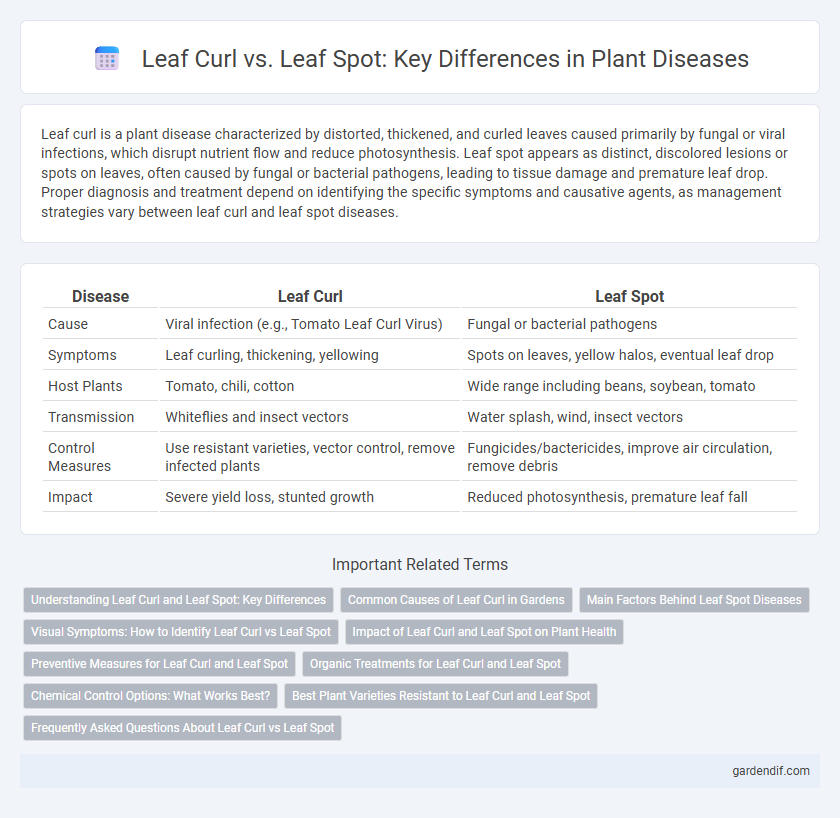
Leaf Curl vs Leaf Spot Illustration
Leaf curl is a plant disease characterized by distorted, thickened, and curled leaves caused primarily by fungal or viral infections, which disrupt nutrient flow and reduce photosynthesis. Leaf spot appears as distinct, discolored lesions or spots on leaves, often caused by fungal or bacterial pathogens, leading to tissue damage and premature leaf drop. Proper diagnosis and treatment depend on identifying the specific symptoms and causative agents, as management strategies vary between leaf curl and leaf spot diseases.
Table of Comparison
| Disease | Leaf Curl | Leaf Spot |
|---|---|---|
| Cause | Viral infection (e.g., Tomato Leaf Curl Virus) | Fungal or bacterial pathogens |
| Symptoms | Leaf curling, thickening, yellowing | Spots on leaves, yellow halos, eventual leaf drop |
| Host Plants | Tomato, chili, cotton | Wide range including beans, soybean, tomato |
| Transmission | Whiteflies and insect vectors | Water splash, wind, insect vectors |
| Control Measures | Use resistant varieties, vector control, remove infected plants | Fungicides/bactericides, improve air circulation, remove debris |
| Impact | Severe yield loss, stunted growth | Reduced photosynthesis, premature leaf fall |
Understanding Leaf Curl and Leaf Spot: Key Differences
Leaf Curl is a fungal disease characterized by the distortion, thickening, and curling of leaves, commonly caused by Taphrina deformans in stone fruit trees. In contrast, Leaf Spot refers to various fungal or bacterial infections, such as those caused by Cercospora or Bipolaris species, resulting in distinct necrotic spots on foliage. Recognizing these key differences in symptoms and causative agents is essential for effective diagnosis and targeted disease management in agricultural practices.
Common Causes of Leaf Curl in Gardens
Leaf curl in gardens is primarily caused by fungal pathogens such as Taphrina deformans, which infects peach, nectarine, and almond trees, leading to distorted and thickened leaves. Environmental factors including excessive moisture, poor air circulation, and sudden temperature changes also contribute significantly to the development of leaf curl. Insect infestations and nutrient deficiencies can exacerbate symptoms, further weakening plant defenses against fungal infections.
Main Factors Behind Leaf Spot Diseases
Leaf spot diseases primarily result from fungal pathogens such as Cercospora, Alternaria, and Septoria, which thrive in warm, moist environments promoting rapid spore germination and infection. Environmental factors including excessive rainfall, high humidity, and poor air circulation create optimal conditions for the development and spread of leaf spots. Nutrient deficiencies and plant stress can further exacerbate susceptibility to leaf spot pathogens, distinguishing these diseases from leaf curl, which is often caused by viral infections or insect vectors.
Visual Symptoms: How to Identify Leaf Curl vs Leaf Spot
Leaf curl manifests as thickened, distorted, and puckered leaves with a characteristic upward or downward curling, often accompanied by discoloration such as yellowing or reddish hues. Leaf spot presents as small, circular or irregularly shaped lesions that vary in color from brown to black, frequently with a yellow halo surrounding the spots. Differentiating these diseases relies on observing leaf texture changes and curling in leaf curl versus distinct, localized necrotic spots in leaf spot.
Impact of Leaf Curl and Leaf Spot on Plant Health
Leaf curl causes severe deformation of leaves, reducing photosynthetic efficiency and stunting plant growth, leading to significant yield losses. Leaf spot primarily damages leaf tissue through necrotic lesions, diminishing the plant's ability to photosynthesize and increasing susceptibility to secondary infections. Both diseases compromise overall plant vigor, but leaf curl often results in more pronounced physiological stress and crop damage.
Preventive Measures for Leaf Curl and Leaf Spot
Preventive measures for leaf curl include selecting resistant plant varieties, applying neem oil or copper-based fungicides before symptoms appear, and maintaining proper irrigation to minimize leaf wetness. For leaf spot, regular pruning to improve air circulation, removing infected leaves promptly, and using fungicidal sprays such as chlorothalonil or mancozeb can reduce disease spread. Implementing crop rotation and avoiding overhead watering are essential strategies to prevent both diseases effectively.
Organic Treatments for Leaf Curl and Leaf Spot
Organic treatments for leaf curl include the application of neem oil and sulfur-based sprays, which help control fungal infections caused by Taphrina deformans. For leaf spot, copper-based fungicides and baking soda sprays are effective in managing bacterial and fungal pathogens such as Alternaria and Septoria species. Maintaining proper plant hygiene, removing infected leaves, and ensuring adequate air circulation enhance the efficacy of these organic solutions.
Chemical Control Options: What Works Best?
Effective chemical control of leaf curl primarily involves fungicides containing copper-based compounds or systemic agents like myclobutanil, which target the causative fungal pathogens. For leaf spot diseases, broad-spectrum fungicides such as chlorothalonil or mancozeb prove effective by inhibiting spore germination and lesion expansion. Selecting fungicides based on the specific pathogen, application timing, and environmental conditions optimizes disease management outcomes for both leaf curl and leaf spot.
Best Plant Varieties Resistant to Leaf Curl and Leaf Spot
Tomato varieties such as 'Celebrity' and 'Juliet' exhibit strong resistance to leaf curl virus, while cultivars like 'Rutgers' and 'Better Boy' show effective defense against leaf spot diseases caused by fungal pathogens. Resistant plant varieties significantly reduce the need for chemical treatments and improve crop yields by minimizing leaf damage and disease spread. Selecting disease-resistant cultivars tailored to local climate conditions enhances overall plant health and durability against common leaf diseases.
Frequently Asked Questions About Leaf Curl vs Leaf Spot
Leaf Curl is typically caused by fungal infections like Taphrina deformans, resulting in thickened, puckered leaves, whereas Leaf Spot is often due to various fungal or bacterial pathogens creating dark, necrotic lesions on foliage. Treatment for Leaf Curl involves copper-based fungicides applied in early spring, while managing Leaf Spot requires removing infected leaves and using fungicides tailored to the specific pathogen. Correct identification and timely intervention are essential to prevent yield loss and maintain plant health in affected crops.
Leaf Curl vs Leaf Spot Infographic

 gardendif.com
gardendif.com